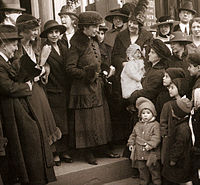First birth control clinic in the U.S.
| Birth control movement in the United States |
|
|---|---|

Margaret Sanger leaving a courthouse
in New York in 1917 |
|
| Description | A reform movement to overturn anti-contraception laws |
| Rights |
Freedom of speech Reproductive rights Women's rights |
| When | 1914 – c. 1945 |
| Leaders |
Mary Dennett Emma Goldman Margaret Sanger |
| Early texts |
The Woman Rebel Motherhood in Bondage What Every Girl Should Know |
| Organizations |
National Birth Control League American Birth Control League Planned Parenthood |
| Court cases |
One Package Griswold v. Connecticut Eisenstadt v. Baird |
The birth control movement in the United States was a social reform campaign from 1914 to around 1945 that aimed to increase the availability of contraception in the U.S. through education and legalization. The movement began in 1914 when a group of political radicals in New York City, led by Emma Goldman, Mary Dennett, and Margaret Sanger, became concerned about the hardships that childbirth and self-induced abortions brought to low-income women. Sanger, in particular, simultaneously sought to connect birth control to the organized eugenics movement, regularly appealing to the authority of eugenic scientists Karl Pearson, Charles Davenport, and others in her Birth Control Review from the early 1920s Such figures sought to prevent population segments they deemed genetically 'undesirable' from reproducing. While seeking legitimacy for the birth control movement partly through the approval of organized eugenics, Sanger and other activists also worked on the political front. Since contraception was considered to be obscene at the time, the activists targeted the , which prohibited distribution of any "obscene, lewd, and/or lascivious" materials through the mail. Hoping to provoke a favorable legal decision, Sanger deliberately broke the law by distributing The Woman Rebel, a newsletter containing a discussion of contraception. In 1916, Sanger opened the first birth control clinic in the United States, but the clinic was immediately shut down by police, and Sanger was sentenced to 30 days in jail.
A major turning point for the movement came during World War I, when many U.S. servicemen were diagnosed with venereal diseases. The government's response included an anti-venereal disease campaign that framed sexual intercourse and contraception as issues of public health and legitimate topics of scientific research. This was the first time a U.S. government institution had engaged in a sustained, public discussion of sexual matters; as a consequence, contraception transformed from an issue of morals to an issue of public health.
...
Wikipedia
